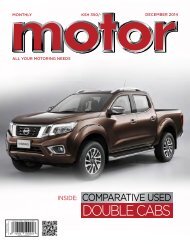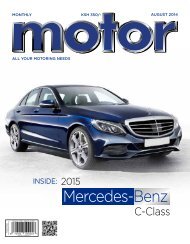Monthly Motor - June 2014
All Your Motoring Needs from Kenyan Publishers Media 7 Group
All Your Motoring Needs from Kenyan Publishers Media 7 Group
You also want an ePaper? Increase the reach of your titles
YUMPU automatically turns print PDFs into web optimized ePapers that Google loves.
Headlight<br />
<strong>Motor</strong>Sure<br />
Defensive<br />
driving<br />
Private <strong>Motor</strong> Insurance.<br />
For peace of mind insure your car with UAP.<br />
For more information contact us on 0711 065100<br />
You may be an excellent driver and<br />
a master of road rules, but there’s<br />
nothing like a basic knowledge<br />
of defensive driving to minimize<br />
risks on the road. The following are<br />
important defensive driving techniques:<br />
Intentions<br />
Sudden stops, turns, and lane changes often<br />
lead to accidents because they catch other<br />
drivers by surprise. Hence, one of the basic<br />
rules of defensive driving is to clearly communicate<br />
to other drivers exactly what you are<br />
about to do. For this reason, it is crucial that<br />
your brake lights, head lights, signal indicators<br />
and other driving lights are working. If they<br />
are not, have them checked right away.<br />
Be predictable<br />
Having all your indicators in good working<br />
order is great, but they won’t help much if you<br />
can’t be predictable. Defensive driving is synonymous<br />
with being predictable. If you’re signalling<br />
a left turn, then make a left turn. Don’t<br />
signal that you’re going left then suddenly<br />
turn right. Don’t keep signalling a left or right<br />
turn then continue driving straight ahead for a<br />
great distance. In defensive driving, one never<br />
makes a move that confuses other drivers on<br />
the road. Surprises are great, but never when<br />
you’re driving.<br />
Route<br />
Always be sure where you want to go. There’s<br />
nothing quite as dangerous as making a sudden<br />
turn or stop, which is something that<br />
drivers do when they are not sure about where<br />
they are headed. If you’re confused about<br />
where you want to go, you’re probably doing<br />
the same to other road users as well. If you’re<br />
lost, park your car and regain your bearings.<br />
Check a map or even ask someone for directions.<br />
The worst thing you can do is drive<br />
around aimlessly.<br />
Signalling<br />
One of the best defensive driving techniques is<br />
to signal every time you turn or change lanes.<br />
That way, you never catch other drivers by<br />
surprise. Make signalling a habit. Even if the<br />
road appears to be deserted and there seem<br />
to be no other cars around, signalling your<br />
intent is always an excellent defensive driving<br />
practice.<br />
Warning<br />
When making a full stop or slowing down for<br />
whatever reason, it’s a good defensive driving<br />
technique to let other drivers know of your<br />
intention. You can do this by tapping the brake<br />
pedal a couple of times so that your brake<br />
lights flash and clue in others behind you that<br />
you are slowing down or stopping. This is<br />
especially important if the driver behind you<br />
is driving fast and approaching quickly.<br />
Anticipate the worst<br />
In defensive driving, it pays to anticipate the<br />
mistakes of other drivers on the road. For<br />
instance, many drivers routinely signal a turn<br />
but don’t turn at all. Meanwhile, others don’t<br />
signal at all and then suddenly turn. Many<br />
people disregard stop signals or try to run red<br />
traffic lights. So keep a watchful eye out for<br />
these instances.<br />
www.uap-group.com<br />
6<br />
MOTOR JUNE <strong>2014</strong>

















